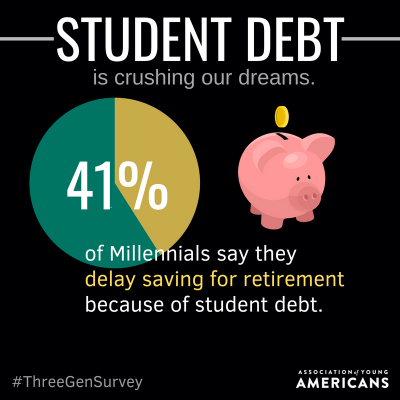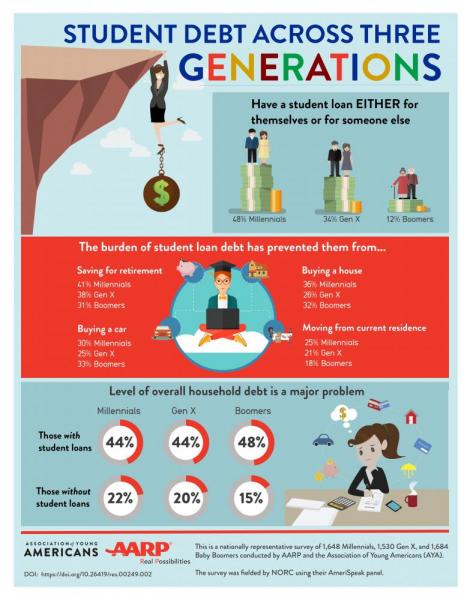New Research from Association of Young Americans & AARP Surveys Three Generations
WASHINGTON, DC— New research released today from the Association of Young Americans AYA (AYA) and AARP show student loan debt preventing Americans across three generations from saving for retirement or buying a home. As many students begin their academic year, nearly half of those with student loan debt say they owe more than $30,000. According to the Federal Reserve Bank of New York, borrowers have over $1.4 trillion in student loan debt. The new research specifically shows that of those who have student debt, 45 percent of Millennials, 48 percent of Generation Xers, and 50 percent of Boomers owe $30,000 or more.
AYA and AARP have released the first findings of their research taking a close look at similarities and differences in the opinions of the Millennial, Generation X, and Baby Boomer generations. In addition to the sentiments on student loans, upcoming findings examine financial security, voter and civic engagement and other areas of interest.
The research below covers student loan debt and sentiments about higher education. The purpose of the survey is to highlight how three generations view major issues facing the nation.
“The trillion dollar student loan crisis is clearly having a tangible impact on all Americans across all generations,” said AYA Founder Ben Brown. “The impacts of this crisis have deep consequences on our economy as a whole, with the majority of Americans noting that student loan debt has been a barrier in making key life decisions and planning for the future. AYA teamed up with AARP on this research to better understand that impact and how young and older Americans can come together on calling for a higher education system that works better for us all.”
“AYA and AARP are working together because issues of financial security, that include growing student loan debt, are important to AARP’s members, their families and many Americans of all ages,” said AARP Senior Vice President Jean Setzfand. Millennials, Gen Xers and Boomers have far more similarities than differences. This research highlights the long-term negative toll student loan debt has on multiple generations. The choice to fund your or your loved ones education can boost your family’s future opportunities. However, due to the high cost of education, our joint research shows that the education decision should be considered in the context of other major financial decisions such as retirement savings, home ownership and paying for other necessities such as healthcare.”
Student loan debt has prevented or delayed:
- Saving for retirement - 4 in 10 (40 percent) say student loan debts have stopped them from saving for retirement, including 41 percent of Millennials, 38 percent of GenXers, and 31 percent of Boomers.
- Buying a home - 1 in 3 (32 percent) say student loan debt has prevented or delayed them from buying a home, including 36 percent of Millennials, 26 percent of GenXers, and 32 percent of Boomers.
- Helping a family member - 1 in 4 (25 percent) say student loan debt prevented or delayed them from financially helping a family member, including 23 percent of Millennials, 29 percent of GenXers, and 26 percent of Boomers.
- Getting health care - Nearly 1 in 5 (16 percent) said student loan debt prevented or delayed them from getting the health care they need including 17 percent of Millennials, 16 percent of GenXers, and 9 percent of Baby Boomers.
6 in 10 Americans don’t view the benefits of college as worth the cost. Across generations, the views about college as not worth the cost held steady with 61 percent of Millennials, 62 percent of Generation X, and 53 percent of Baby Boomers sharing the same view.
Americans believe major institutions can play a role in the cost of college and loan repayment:
Colleges –
- 3 in 4 (74 percent) agree strongly or somewhat that community colleges should be free for anyone who qualifies.
- 6 in 10 (66 percent) agree strongly or somewhat that colleges and universities should share the financial responsibility with students who default on their loans.
Government –
- Over 8 in 10 (86 percent) agree strongly or somewhat that state and federal government should invest in career and technical education programs as alternatives to college.
- 8 in 10 (79 percent) believe strongly or somewhat that state government should increase support for public universities so more people can afford college tuition.
- 7 in 10 (76 percent) strongly or somewhat believe that the federal government should help people refinance student loan debt.
- 6 in 10 strongly or somewhat agree that the federal government should forgive some student loan debt (61 percent), help people repay some student loan debt (58 percent), and tax stock market transactions to subsidize tuition at public colleges and universities (60 percent).
After the release of the final set of findings the full data set for the poll will be available. Specific data from the poll may be available upon request before the full data is released. These survey results do not necessarily reflect the policy positions of AYA or AARP.
Methodology: This poll was conducted via NORC’s AmeriSpeak nationally representative online panel for AARP from July 10, 2018 to August 7, 2018, with 4,862 adults between the ages of 18-74 encompassing Millennial, Generation X, and Baby Boomer adults. The margin of error is +/-2.01% at the 95% confidence level. The sample includes nationally representative samples of African-Americans and Hispanic-Americans.
# # #
About AARP
AARP is the nation’s largest nonprofit, nonpartisan organization dedicated to empowering Americans 50 and older to choose how they live as they age. With nearly 38 million members and offices in every state, the District of Columbia, Puerto Rico, and the U.S. Virgin Islands, AARP works to strengthen communities and advocate for what matters most to families with a focus on health security, financial stability and personal fulfillment. AARP also works for individuals in the marketplace by sparking new solutions and allowing carefully chosen, high-quality products and services to carry the AARP name. As a trusted source for news and information, AARP produces the nation's largest circulation publications, AARP The Magazine and AARP Bulletin. To learn more, visit www.aarp.org or follow @AARP and @AARPadvocates on social media.
Contacts:
Association of Young Americans (AYA) – aya@ellecomm.com, @AYAmericans, @ellecomm
AARP Media Relations – 202-434-2560, media@aarp.org, @AARPMedia

































































